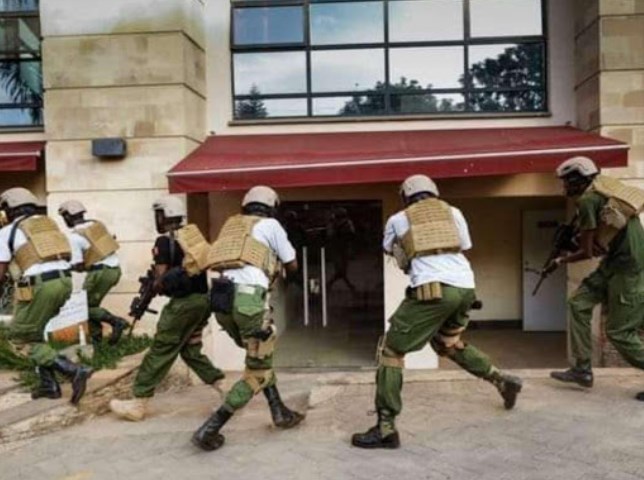
by CYRUS OMBATI
Wednesday January 8, 2025
- Mire has been involved with al-Shabaab in financing, planning, facilitating, preparing, or executing attacks in both Kenya and Somalia.
- During the Westgate attack on September 21, 2013, four attackers entered the mall in Nairobi and shot and killed several civilians.

Police officers during the Dusit D2 attack
The US has confirmed that al-Shabaab leader Mohamed Mire also known as Abu Abdirahman, who served as the militant group's finance head during the Westgate Mall and Dusit-D2 attacks in 2013 and 2019, respectively, was killed in an airstrike on December 24, 2024.
The US Africa Command (USAC) on Monday said it initiated the airstrike near Quyno Barrow, some 260 kilometres from Mogadishu, killing two al-Shabaab militants, including Mire.
“Mire, also known as Abu Abdirahman, was responsible for al-Shabaab’s regional governance in Somalia for the last 15 years. In addition to being one of al-Shabaab's longest-serving members, Mire served as the interior minister and played a key role in the group's strategic decision-making,” the United States military command in Africa, AFRICOM said in a statement.
AFRICOM said it cannot disclose specifics of the mission, stating only that no civilians were harmed.
“The command will continue to assess the results of the operation and provide additional information as appropriate,” said U.S. Marine Corps Gen. Michael Langley, AFRICOM commander, according to the statement.
Mire has been involved with al-Shabaab in financing, planning, facilitating, preparing, or executing attacks in both Kenya and Somalia.
He was al-Shabaab’s finance head during the Westgate Mall (2013) and DusitD2 (2019) attacks.
During the Westgate attack on September 21, 2013, four attackers entered the mall in Nairobi and shot and killed several civilians.
While the security forces, supported by international partners, managed to kill all four attackers in their response, 62 civilians and five Kenyan Defence Forces officers lost their lives during the four-day siege.
On January 15, 2019, Al-Shabaab launched another attack on Kenyan soil when five militants stormed 14 Riverside Drive in Nairobi.
The attack claimed 22 lives.
Mire was also the head of al-Shabab’s regions department, the militant group’s equivalent of an interior ministry.
He also held multiple other positions within the group.
In July, Somalia’s anti-money laundering committee issued a sanctions list targeting Mire and seven other al-Shabab commanders.
U.S. officials designated Mire a global terrorist in October 2022, describing him as a senior al-Shabab leader responsible for the group’s strategic decision-making and head of the group’s interior wing, overseeing many of the group’s activities in Somalia.
He was listed alongside Yasir Jiis, commander of the group’s intelligence wing Yusuf Ahmed Hajji Nurow, also known as Gees Ade, chief of the Amniyat intelligence wing; and Mustaf Abdi Aden, leader of the cell that planned the DusitD2 complex attack in Kenya in 2019.
“Somalia remains central to the security environment in East Africa. U.S. Africa Command's forces will continue training, advising and equipping partner forces to degrade al-Shabaab,” AFRICOM said.
In 2023, a similar airstrike killed Kenyan Maalim Ayman, another senior leader of the group.
Ayman was linked to the January 2020 attack on the U.S. camp at Manda Bay in Lamu, which claimed the lives of three U.S. nationals, including one service member.
Al-Shabab, which has been fighting the Somali government for more than 15 years, controls large areas in southern Somalia and pockets in the central region of the country.